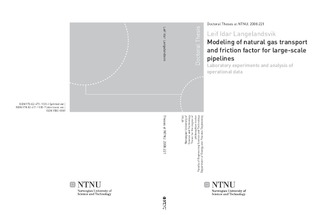| dc.contributor.author | Langelandsvik, Leif Idar | nb_NO |
| dc.date.accessioned | 2014-12-19T11:43:48Z | |
| dc.date.available | 2014-12-19T11:43:48Z | |
| dc.date.created | 2009-02-11 | nb_NO |
| dc.date.issued | 2008 | nb_NO |
| dc.identifier | 202221 | nb_NO |
| dc.identifier.isbn | 978-82-471-1131-4 (printed ver.) | nb_NO |
| dc.identifier.isbn | 978-82-471-1130-7 (electronic ver.) | nb_NO |
| dc.identifier.uri | http://hdl.handle.net/11250/233400 | |
| dc.description.abstract | The overall objective of this work was to improve the one-dimensional models used to simulate the transport of single-phase natural gas in Norway’s large-diameter export pipelines. There was a particular focus on the simulator used by the state-owned company Gassco named Transient Gas Network (TGNet). This simulator was studied in order to uncover any weaknesses or inaccuracies and to predict the natural gas transport with better accuracy both in the daily operation and when long-term capacity calculations are made.
The conclusion was that the simulator in general resolves the physics well, provided that the input correlations such as viscosity correlation and friction factor correlation are accurate. The simulator was therefore found trustworthy to be used in the determination of the friction factor for operational data. No satisfactory correlations exist for the additional pressure loss in smooth curves, and like all other commercial simulators TGNet ends up modeling only a straight pipe. This is a weakness, but the magnitude of the associated error is unknown. The simulator also fails to predict the heat transfer for partly buried pipelines.
The sensitivity analysis performed on an artificial pipeline model as well as the uncertainty analysis for the full-scale experiments both indicated which parameters are most important in the simulations:
• Gas density calculations
• Ambient temperature (affecting the gas temperature)
• Flow rate measurements
• Inner diameter of pipeline
The fricton factor was analyzed both by means of laboratory experiments in the high Reynolds number facility Superpipe at Princeton University in US and by comprehensive analysis of real operational data at the largest Reynolds numbers ever covered.
The Superpipe measurements were made on a 5 inch inner diameter natural rough steel pipe, and covered both the smooth, transitionally rough and the fully rough region. Reynolds numbers from 150·103 to 20·106 were covered. Due to lack of studies on naturally rough surfaces in literature, these measurements yielded very interesting results. The transition zone was abrupt, but was neither a point transition nor an inflectional transition. The equivalent sand grain roughness was furthermore found to be 1.6 times the measured root mean square roughness, which is in contrast to the value of 3.0 to 5.0 that is commonly used.
Operational data were collected from two full-scale steel pipelines with an inner diameter of 40 and 42 inches respectively, covering Reynolds numbers from 10·106 to 45·106 . The experiments showed friction factors signicantly lower than predicted by the Colebrook-White correlation and based on reported roughness measurements. It was also concluded that the pipelines are in the transition zone which is more abrupt than that of Colebrook-White.
Increased knowledge about the frictional pressure drop at large flow rates resulting from analysis of operational data has led to updated and increased capacity calculations in several pipelines. The increase is in the range 0.2-1.0%, and facilitates an improved utilization of the natural gas transport infrastructure on the Norwegian Continental Shelf.
This work includes three different papers, one presented at an international conference and two published in peer-reviewed international journals.
| nb_NO |
| dc.language | eng | nb_NO |
| dc.publisher | Norges teknisk-naturvitenskapelige universitet, Fakultet for ingeniørvitenskap og teknologi, Institutt for energi- og prosessteknikk | nb_NO |
| dc.relation.ispartofseries | Doktoravhandlinger ved NTNU, 1503-8181; 2008:221 | nb_NO |
| dc.title | Modeling of natural gas transportand friction factor for large-scale pipelines: Laboratory experiments and analysis of operational data | nb_NO |
| dc.type | Doctoral thesis | nb_NO |
| dc.contributor.department | Norges teknisk-naturvitenskapelige universitet, Fakultet for ingeniørvitenskap og teknologi, Institutt for energi- og prosessteknikk | nb_NO |
| dc.description.degree | PhD i energi- og prosessteknikk | nb_NO |
| dc.description.degree | PhD in Energy and Process Engineering | en_GB |

